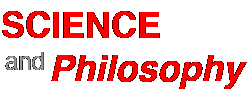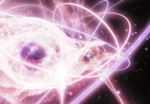The Quantum
Revolution
The real revolution in twentieth-century science is that of quantum
physics… After all else has been duly recognized and credited,
it was finally in the submicroscopic interstices of the atom—rather
than in the telescopic reaches of outer space or the macroscopic
world of everyday experience—that the primary postulates and
“necessary truths” of the Newtonian cosmology were one
by one brought under critical scrutiny, and one by one found wanting.
Although the quantum theory was originally formulated by Max Planck at the turn of the century, its startling hypothesis—that energy is emitted not in the continuous stream of common supposition but in discontinuous packets or quanta —was only gradually and grudgingly acknowledged by his fellow physicists. The reason was not simply, as in the case of Maxwell, that the quantum of energy resisted representation in terms of a mechanical model; more disturbingly, its assertion of discontinuity at the bottom of things rudely violated the cardinal faith of modern science in the uniformity and continuity of nature —specifically, its belief that the evolution of every self-contained physical system is constituted by a continuous chain of causally related events. Only after “Planck’s constant” and its theoretical underpinning had proved successful in a number of physical applications—most notably in Einstein’s extension of the principle to all forms of radiant energy through the establishment of the photoelectric effect—was the new conception fully accepted as a fundamental law of physical science.
The extent of the revolution which this discovery ushered in is suggested by the observation of de Broglie that, “on the day when quanta, surreptitiously, were introduced the vast and grandiose edifice of classical physics found itself shaken to its very foundations. In the history of the intellectual world there have been few upheavals comparable to this.”
Through the next half-century the quantum theory steadily made its way into nearly every department of physical science. In addition to Einstein’s Nobel Prize-winning researches, the principle found a variety of fruitful applications in chemistry, it shed light upon the Third Law of Thermodynamics; it modified the kinetic theory of gases; it was (most significantly of all) applied by Bohr to explain the structure of atoms, and later by Dirac in his prediction of the positron. Even Maxwell’s equations underwent reappraisal in an effort to adjust them to the new ideas.
More recently, there have been public suggestions that “space” itself may be found to adhere to the quantum principle—a conception whose reverberations may conceivably outdistance all previous extensions of the theory.” “In short,” as one historian summarizes, “optics, mechanics, thermodynamics, chemistry, the statistical laws, and many others have one by one come under the sway of the quantum theory. Needless to say, our entire outlook on the physical world has been affected.”
The hypothesis of energy radiation as finite and discontinuous, which was central to the quantum theory from the beginning, shook the confidence of scientists in the order and continuity of natural processes. But it was not until 1913 that the first major offensive of quantum physics against the traditional cosmology—namely, its attack upon the deterministic conception of physical causality—was launched with the publication of Niels Bohr’s theory of the atom, which demonstrated that the entire internal organization of matter rests upon the existence of quanta.
Bohr’s atom represented the most complete break with classical physics yet accomplished, and, through its hypothesis of the unpredictability of individual atomic events, provided “the first set of arguments in favour of indeterminism” in the fundamental operations of nature. Later experiments led to the displacement of Bohr’s pioneer theory, but the rupture with traditional mechanics which it had signalled, far from being repaired, was progressively widened and reinforced in the subsequent development of quantum physics—not least of all through the creative contributions of Bohr himself.


